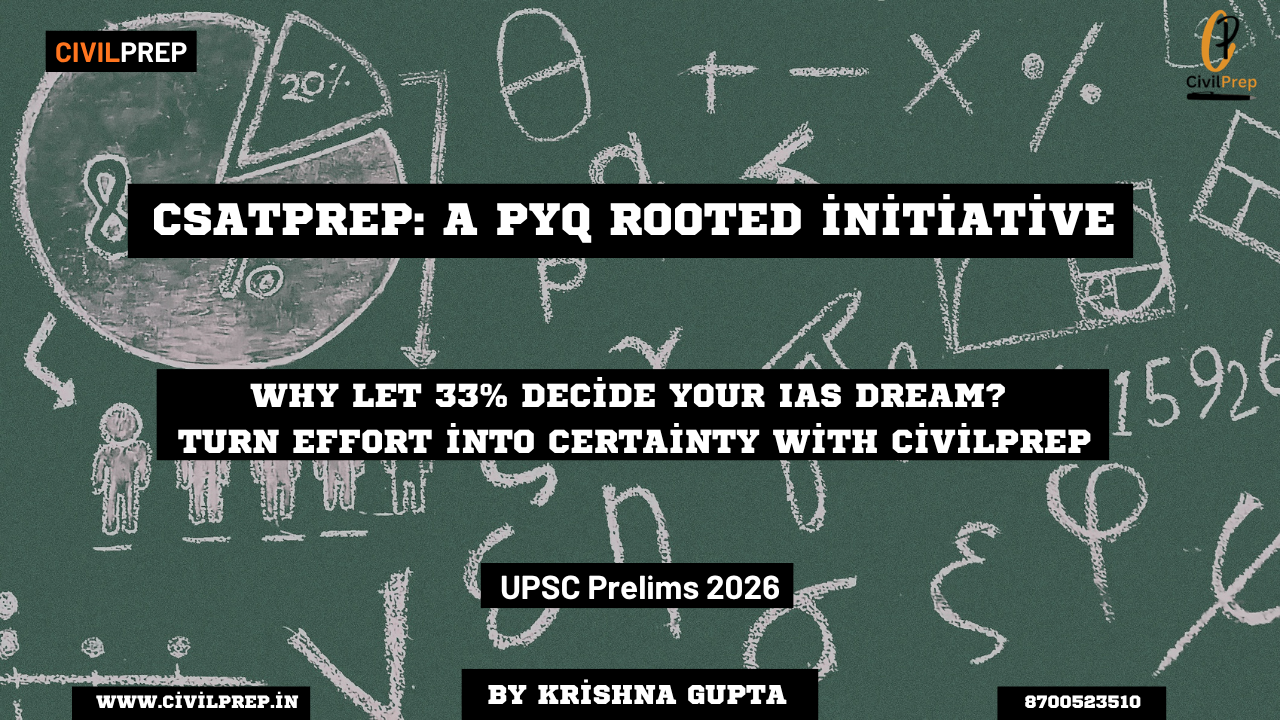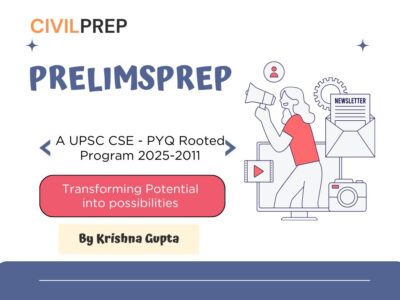Why let CSAT’s 33% decide your IAS dream?
CSATPrep: A Comprehensive 100-Day PYQ Rooted Initiative for UPSC Civil Services Aptitude Test
Understanding CSAT in UPSC CSE
The Civil Services Aptitude Test (CSAT), officially known as General Studies Paper II, is the second paper of the UPSC Preliminary Examination. Introduced in 2011, CSAT serves as a qualifying paper designed to assess candidates’ comprehension, logical reasoning, analytical ability, decision-making skills, and basic numeracy.
Key Features of CSAT:
– Total Marks: 200 marks
– Number of Questions: 80 questions (each carrying 2.5 marks)
– Duration: 2 hours
– Qualifying Marks: 33% (66 marks out of 200) for all categories
– Negative Marking: Yes, 1/3rd or 0.83 marks deducted for each wrong answer
– Nature: Qualifying only—scores do not count toward merit ranking, but failure to qualify results in disqualification even if GS Paper I score is high
CSAT Syllabus: Detailed Breakdown
The official UPSC CSAT syllabus comprises seven broad areas:
1. Comprehension
Reading passages followed by questions testing understanding, inference, and interpretation skills. This section typically contains 26-30 questions covering diverse themes including education, climate change, governance, economics, and philosophy.
2. Interpersonal Skills Including Communication Skills
Questions on verbal interpretation, analogies, and critical reasoning.
3. Logical Reasoning and Analytical Ability
– Sequence and series
– Coding and decoding
– Blood relations
– Venn diagrams
– Direction and distance
– Seating arrangements
– Puzzles
– Syllogisms
– Statement and conclusions
– Cause and effect
4. Decision Making and Problem Solving
Ethical dilemmas and hypothetical scenario-based questions.
5. General Mental Ability
Mathematical topics including:
– Profit and loss
– Mixture and alligations
– Time and work
– Time and distance
– Geometry and mensuration
– Partnerships
– Clocks and calendars
6. Basic Numeracy (Class X Level)
– Number systems
– LCM and HCF
– Rational numbers and ordering
– Decimal fractions
– Simplification
– Square roots and cube roots
– Fractions
– Ratio and proportion
– Averages
– Percentages
– Simple and compound interest
7. Data Interpretation (Class X Level)
Analysis of charts, graphs, tables, bar graphs, pie charts, line graphs, and data sufficiency questions.
CSAT Trend Analysis: Previous Year Questions (PYQs)
Analyzing PYQ patterns reveals crucial insights for strategic preparation:
Topic-wise Distribution (2015-2025):
Comprehension (English): Consistently the highest weightage section with 26-32 questions annually. CSAT 2025 featured 29 questions from 16 passages, ranging from moderate to difficult, requiring inference and assumption analysis.
Quantitative Aptitude (Mathematics): Shows increasing trend from 15 questions (2014-2015) to 38-45 questions (2020-2024). CSAT 2025 had 33 questions focusing on number systems, percentages, profit and loss, and data sufficiency.
Logical Reasoning: Declining trend from 22-25 questions (2015-2017) to 10-18 questions (2020-2025). CSAT 2025 included only 18 questions covering puzzles, direction sense, arrangements, and syllogisms.
Key Observations:
The shift indicates CSAT is moving toward quantitative aptitude emphasis while reducing reasoning weightage. Comprehension remains consistently important, testing analytical depth rather than speed reading.
CSATPrep: The 100-Day Initiative
CSATPrep is a structured, PYQ-rooted program starting November 6, 2025, designed to transform CSAT from a qualifying hurdle into a strength through systematic preparation.
Program Structure:
Duration: 100 days of intensive, focused preparation
Components:
1. Comprehensive PYQ Coverage: Topic-wise analysis and practice of previous year questions from 2011-2025
2. 6 Sectional Tests: Focused assessments on Mathematics, Reasoning, and Comprehension
3. 2 Full-Length Mock Tests: Complete exam simulation with detailed performance analysis
|
Section |
Total Days |
|
Quantitative Aptitude |
45 days |
|
Logical Reasoning |
30 days |
|
Reading Comprehension |
25 days |
|
Total Study Days |
100 days |
Why PYQ-Rooted Approach Works
Previous Year Questions form the backbone of effective CSAT preparation because they:
1. Reveal Question Patterns: Understanding how concepts are tested year after year
2. Identify Important Topics: Focus preparation on high-weightage areas
3. Build Familiarity: Reduce exam anxiety through repeated exposure to question styles
4. Enhance Accuracy: Learn to avoid common traps and negative marking pitfalls
5. Save Time: Recognize patterns that enable faster problem-solving
Strategic Benefits of 100-Day Timeline
Research shows that 100 days with 7 hours of productive daily study equals 700 hours—sufficient for comprehensive CSAT mastery when strategically allocated. This duration allows:
– Multiple revisions of all topics (minimum 3-4 times)
– Adequate practice through sectional and full-length tests
– Error analysis and correction time
– Stress-free preparation without burnout
– Flexibility for unexpected events while maintaining momentum
Recommended Resources for CSATPrep
For Mathematics:
– R.S. Agarwal’s Quantitative Aptitude for Competitive Examinations
– Rajesh Verma’s Fast Track Objective Arithmetic
**For Reasoning:**
– R.S. Agarwal’s A Modern Approach to Verbal and Non-Verbal Reasoning
– M.K. Pandey’s Analytical Reasoning
For Comprehension:
– Daily newspaper reading (The Hindu, Indian Express)
– Norman Lewis’s Word Power Made Easy
– CSAT Paper II: Reading Comprehension by Ashok Kumar Singh
Complete Coverage:
– Arihant’s Cracking The CSAT Paper-2 (includes 20 practice papers)
– Pearson’s CSAT Manual
– Previous year question papers (2011-2025)
Importance of CSAT in Overall UPSC Strategy
While CSAT is qualifying, underestimating it can be catastrophic. Even candidates scoring exceptionally high in GS Paper I are disqualified if they don’t secure 66 marks in CSAT. The 2025 CSAT was reported as **moderate to moderately difficult and time-consuming, highlighting the need for dedicated preparation.
Many aspirants, particularly from arts and humanities backgrounds, struggle with the quantitative and reasoning sections. A structured 100-day program like CSATPrep addresses these challenges systematically, ensuring no candidate’s IAS dream ends at the qualifying stage.
Don’t Let 33% Decide Your IAS Dream
The tagline “Why let CSAT’s 33% decide your IAS dream?” captures a fundamental truth: while CSAT requires only 33% to qualify, inadequate preparation causes many aspirants to fall short of this seemingly modest threshold. With **100% preparation through CSATPrep, candidates can convert CSAT anxiety into absolute accuracy, ensuring their civil services journey continues beyond Prelims.
CSATPrep starting November 6, 2025, offers aspirants the perfect timeline, PYQ-rooted methodology, comprehensive testing framework, and strategic guidance to not just qualify CSAT, but master it—transforming a potential elimination point into a confident strength in their UPSC Civil Services journey.
Course Features
- Lecture 0
- Quiz 0
- Duration 10 weeks
- Skill level All levels
- Language English
- Students 0
- Assessments Yes
Curriculum
- 3 Sections
- 0 Lessons
- 10 Weeks
- Quantitative Aptitude0
- Reasoning0
- Reading Comprehension0







